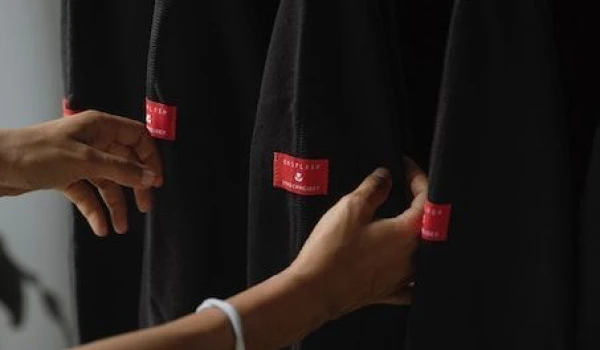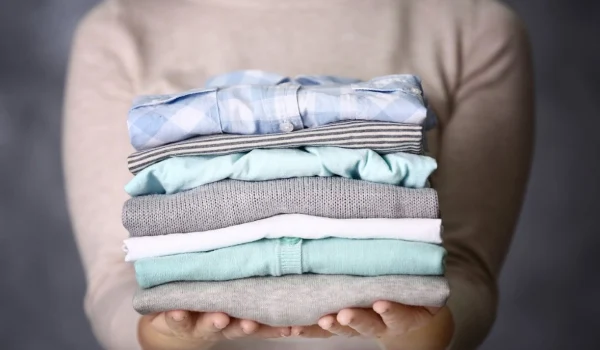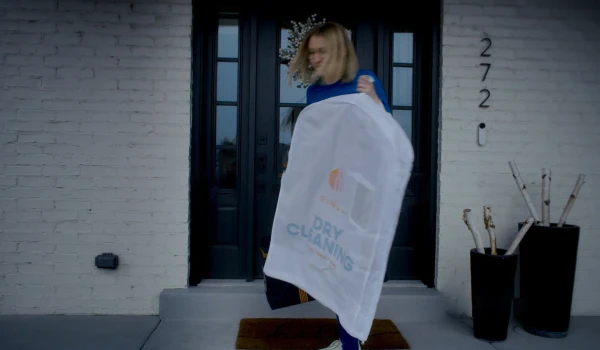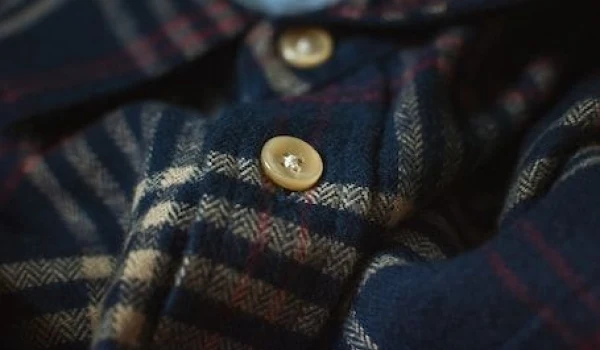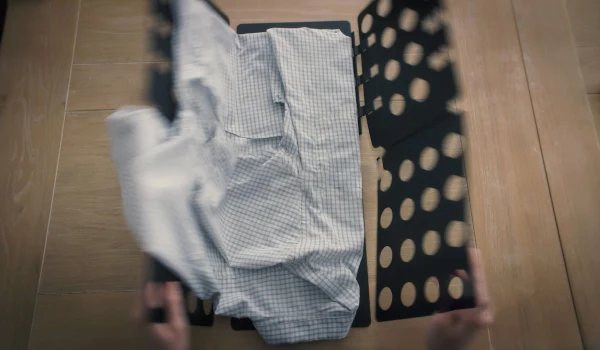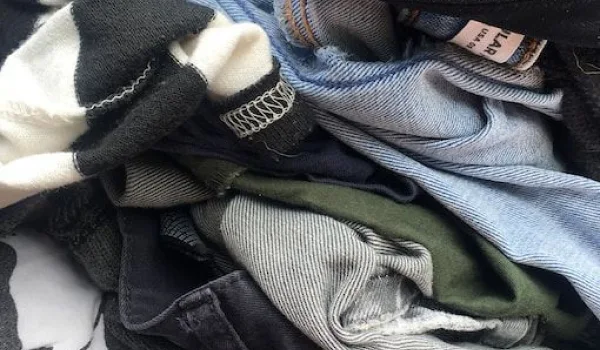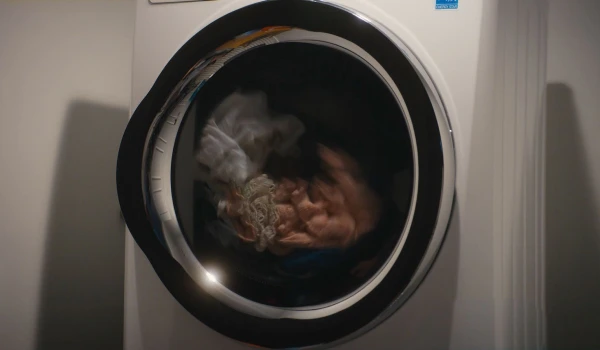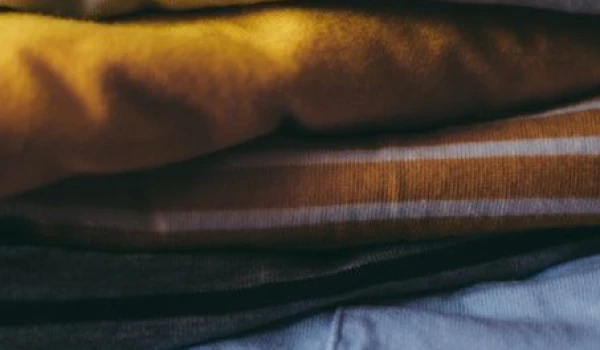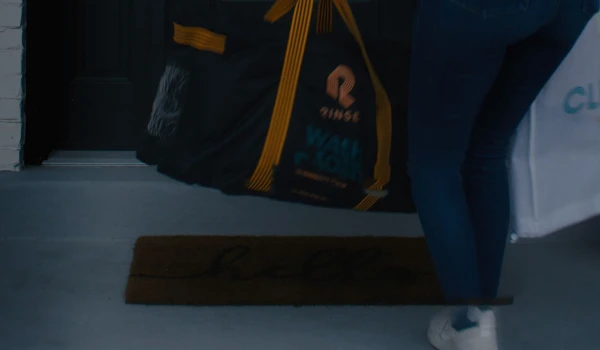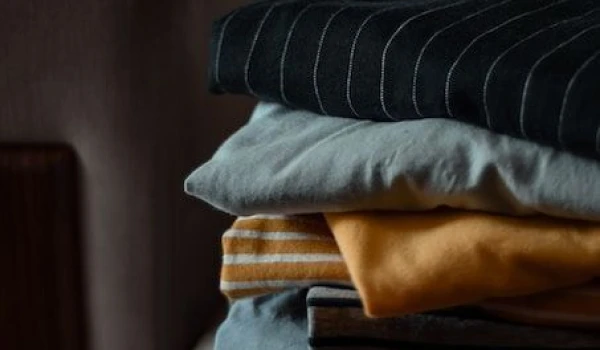Care
Clothing care tips to make your wardrobe last

The article underscores the critical importance of laundry room and detergent safety, emphasizing the risks and promoting the long-term benefits of a secure laundry environment. It then offers a list of detailed detergent safety tips, covering storage, handling, and usage guidelines to ensure readers adopt best practices in safeguarding themselves and their surroundings.
Introduction
Whether you have sensitive skin or are conscious of the environmental impact of your laundry routine, familiarity with detergent safety is a must.
Which type of laundry detergent is the safest: powder, pod, or liquid? Is laundry soap better than detergent? How does chlorine bleach rank on the safety scale?
Below, we discuss everything from the selection of the best laundry detergent to the handling and storage of these cleaning agents. We also share some laundry safety tips to help you avoid accidents and chemical exposure.

The Importance of Laundry Room And Detergent Safety
We'll start with laundry room safety first. The laundry room should be off-limits for children, especially those who are at an age where they're curious about everything and are likely to taste whatever they get their hands on.
Experts at the University of Iowa Stead Family Children's Hospital say that parents should keep laundry pods out of reach of their children and store them in a locked cabinet.
A laundry pod attracts young kids because of its colorful appearance and texture. However, it's very dangerous when ingested. The constituents of a laundry detergent pod can cause chemical burns to the mouth, esophagus, and eyes.
Here are some other laundry room safety tips:
-
Do not mix laundry detergent with household cleaners or ammonia. The mixture could release dangerous fumes and result in breathing problems.
-
Do not reuse containers of laundry detergents or bleach. Discard these containers after you use the cleaning product.
-
Clean all spills and drips of detergents or bleach immediately.
-
Keep the laundry room locked so that kids can't access it.
-
Keep spray bottles on top shelves or in locked cabinets.
-
Replace loose caps or nozzles to prevent spills and leaks.

10 Detergent and Laundry Safety Tips
Laundry products contain all sorts of harmful chemicals, such as phthalates, ammonia, and dyes. While some may be hypoallergenic, others can have an irritant effect upon exposure. Follow these safety tips to minimize the risk of these side effects:
Follow the Instructions
Use this advice for everything in life. Always read the instructions before using any laundry product, including detergent pods. The label should tell you how to handle the product safely.
For instance, if you use a powder detergent, it might come with a warning not to mix it with bleach or any other cleaning product. The instructions might also tell you to use gloves or a mask while handling the product.
Dispose Properly
When a laundry detergent container is empty, don't refill it with any other cleaning product. Instead, rinse it with water and put the cap back on. Dispose of it properly, following local regulations.
Store Detergents Safely
By proper storage, we mean safe storage. Do not leave detergent bottles out in the open, where they can be easily reached by kids or anyone who might ingest them.
Use a high shelf to keep all your laundry products, especially if you have children or pets in the household. Alternatively, put everything in a storage cabinet with a lock on it.
Use a Natural Laundry Detergent
Nowadays, many people are opting for natural cleaning products because they're worried about commercial products containing carcinogen components. A natural laundry detergent is a biodegradable and eco-friendly alternative that can be just as effective as regular laundry detergent.
It is free of chemicals like sulfates and phosphates. Plus, it does not have a fragrance. ECOS is a good example of a natural laundry detergent. You can also use the laundry detergent sheet from Earth Breeze. A laundry sheet works just like a regular detergent, but it dissolves in water and does not contain plastic packaging.
If you want to check the eco-friendliness of a laundry detergent, go to the Environmental Working Group (EWG) website. Here, you can find the rating of thousands of products, including dishwashing solutions, floor care, air fresheners, laundry products, etc.
Use the Right Amount
Using less detergent, fabric softener, or stain remover than needed usually translates to clothes coming out of the washer still stained. To fix that, you'll have to run another cycle. That's wasteful.
Similarly, if you use too much of a product, you risk leaving residue and suds on your clothes. Besides making your clothes look dingy, it can also irritate your skin.
Instead, use the right amount of detergent by following the instructions on the product label for the proper dosage. If your clothes are heavily soiled, you may need to use a little more detergent. But in most cases, using the recommended amount should suffice.
Use Gloves If Required
Wear gloves if you're using a heavy-duty detergent or bleach. The chemicals in these products can be harsh on your skin, causing irritation and dryness.
You should also wear gloves during laundry if you have a wound or cuts on your hands. The chemicals can irritate the wound or even worsen it.

Handle Laundry Products with Dry Hands
Wet hands provide laundry products with a solvent to dissolve in. You don't want your hands to be all soapy, do you? So, make sure your hands are completely dry before handling laundry products, especially laundry detergent powder.
Use Natural Cleaning Remedies
Sometimes, you have stubborn stains like those of makeup or grease. Instead of wasting half a bottle of liquid laundry detergent on it, opt for natural remedies.
Vinegar is a good option. Use a mixture of vinegar diluted with water to spot treat a stain. Leave it for about 10 minutes before washing the garment.
You can also use baking soda and hydrogen peroxide to make a paste and apply it to the stained area. Let it sit for a few minutes before washing.
Rubbing alcohol can also be a good alternative to a commercial stain remover. You can use it to remove lipstick stains. Liquid dish soap can cut through oil and grease stains.
Clean Up Spills
Even if it's a clean laundry detergent, do not leave it on the floor. If you spill any of it, clean it up immediately.
Sometimes, it's not the harmful chemicals that are the issue but the slipping hazard. Similarly, your four-legged buddy might start exploring the spill and lick it, which could be harmful to them.
Vacuum any powder spills and wipe up any liquid spills with a damp cloth. Dispose of the used paper towel or cloth properly.
Don't Overcrowd Your Washing Machine
Some of us like to put all our supplies on top of the washing machine. From brighteners and fabric softeners to laundry detergents and stain removers, we have it all there.
It might seem convenient at first, but this setup increases the risk of spills and accidents. Instead, prop up a shelf to hold your supplies. Or, get some cute baskets from the dollar store to keep your laundry essentials organized and easily accessible.

Keeping It Safe With Rinse
Sometimes, homes with children can be a handful. In such cases, it's not always possible to do laundry safely. Maybe your toddler is in their Dora the Explorer era. Or it's the end of the quarter week at work, and you're bombarded with deadlines.
Whatever the reason may be, outsourcing laundry in such situations is a form of self-care. At Rinse, we're all about helping you indulge in some self-care and make your life easier.
Taking laundry off your hands is just the first thing we do. Next, we also remove the hassle of bringing the laundry to us. Just go on our app or website or drop us a text, and we'll pick up your laundry from the comfort of your home.
Once we've taken care of your clothes, our experts will carefully sort, wash, and fold them to perfection. And don't worry about any spills or stains – we'll sort those out, too.
Even better, we offer dry cleaning services because we understand not all clothes can be washed.
Contact us at Rinse today to see our skill in action.

The upcoming article aims to be your trusted guide on caring for wool sweaters and maintaining their quality. It begins by discussing the frequency of washing sweaters and then details methods for washing wool sweaters in the washing machine and by hand. It covers crucial aspects of drying and proper storage post-washing.
Introduction
Wool sweaters are timeless classics, providing warmth and style. However, caring for them requires knowing the right techniques to maintain their quality. Many people fear ruining their cherished wool garments, but with the proper knowledge, you can enjoy their coziness for years to come.
Washing wool sweaters is an art that involves understanding the intricacies of wool care. In this guide, we'll delve into expert tips and techniques to ensure your wool sweaters remain in pristine condition.

How Often Should I Wash My Wool Sweaters?
The frequency of washing wool sweaters depends on various factors, such as usage and odor. Unlike some garments, wool doesn't require frequent cleaning. To maintain freshness while reducing the risk of damage from excessive washing, airing them out between wears is frequently sufficient.
When considering washing wool, it's essential to strike a delicate balance. Let's explore the specifics, including both machine and hand washing methods, addressing concerns like pilling and ensuring proper drying and storage.

How to Wash Wool Sweaters in the Washing Machine
Washing wool sweaters in a machine requires care to preserve their quality. Follow these expert steps for optimal results:
-
Sort by Color and Weight: Separate wool clothes by color to prevent bleeding. Also, consider the weight – wash similar fabrics together.
-
Use a Mesh Laundry Bag: Place wool sweaters in a mesh laundry bag to shield them from friction and reduce the risk of lint.
-
Choose a Wool Wash or Delicate Cycle: Select a detergent specifically designed for wool or opt for a gentle cycle on your machine to minimize stress on the wool fibers. High-speed spins can lead to excessive stretching.
-
Avoid Fabric Softeners: Skip fabric softeners as they can affect the natural fibers of wool. Instead, use a specialized wool wash.
-
Keep it Cool: Opt for cold water to prevent the wool from shrinking – hot water can lead to unwanted changes in size and shape.

How to Hand Wash Wool Sweaters
Hand washing wool sweaters is a meticulous process that ensures their longevity. Follow these steps for a thorough hand wash:
-
Prepare a Gentle Bath: Fill a basin or sink with lukewarm water. Add a small amount of wool detergent or a mild shampoo suitable for delicates.
-
Submerge and Soak: Immerse the wool sweater in the soapy water, ensuring it's fully submerged. Allow it to soak for 10-15 minutes.
-
Gently Agitate: Swish the sweater in the water without aggressive rubbing to avoid distortion.
-
Rinse Carefully: Drain the soapy water and refill the basin with fresh, lukewarm water. Gently rinse the sweater until no detergent remains.
-
Remove Excess Water: Press out excess water by gently squeezing the sweater. Avoid wringing, as it can damage the fibers.
How to Dry Wool Sweaters
Properly drying wool sweaters is crucial to maintaining their shape and quality. Follow these expert tips to ensure the longevity of your wool garments:
-
Gently Remove Excess Water: After washing wool sweaters, press the garment between two clean towels to absorb excess water. Again, avoid wringing or twisting, as this can distort the fibers.
-
Reshape and Lay Flat: Lay the damp wool sweater flat on a clean, dry towel. Gently reshape it to its original dimensions, ensuring the sleeves and body lie flat.
-
Air Dry in a Cool, Shaded Area: Choose a well-ventilated, shaded area for drying. Avoid direct sunlight, as it can cause fading and damage. Allow the sweater to air-dry completely.
-
Utilize a Drying Rack: To enhance airflow during drying, use a drying rack. Position the sweater on the rack, allowing air to circulate around and underneath it.
-
Rotate During Drying: Periodically rotate the sweater during the drying process to ensure even drying and prevent stretching in one direction.
-
Avoid Hanging: Never hang a wet wool sweater, as it can lead to stretching and distortion of the fibers. Always opt for flat-drying.
-
Mothball Protection: Safeguard your wool sweaters from moth damage by incorporating mothballs into your storage routine. These natural repellents help prevent moths from feasting on your cherished garments, ensuring they remain in pristine condition.

How to Store Sweaters Properly After Washing
Proper storage is key to preserving the freshness of your wool sweaters and protecting them from potential damage. Follow these guidelines for post-washing sweater storage:
-
Check for Pilling: While unfortunate, pilling is common with wool, but it's manageable. Use a sweater shaver or a fabric shaver to remove the pills. Alternatively, a gentle rub with a pumice stone can help.
-
Fold Neatly: Instead of hanging, neatly fold the wool sweater to maintain its shape. Avoid causing stress on the shoulders by using padded hangers.
-
Choose a Cool, Dry Storage Space: Opt for a cool, dry storage space to prevent moisture buildup and potential mildew. Avoid damp basements or humid areas.
-
Use Garment Bags or Cotton Storage Bags: Store wool sweaters in breathable garment bags or cotton storage bags. This protects them from dust and potential moth damage.
-
Add Natural Repellents: Place natural moth repellents, such as cedar blocks or lavender sachets, in your storage space to deter pests.
Make Wool Sweater Care a Breeze with Rinse
Preserving the quality of your delicate wool garments is essential, and Rinse is here to make washing wool sweaters a hassle-free experience. Our expert services are tailored to handle the intricacies of wool clothing, ensuring they receive the care they deserve.
Why Choose Rinse for Wool Sweater Care?
1. Professional Handling:
Our experienced team understands the nuances of washing wool clothes, employing professional techniques to maintain their integrity.
2. Quality Detergents:
We use high quality laundry detergent, ensuring effective cleaning without compromising the fabric.
3. Gentle Machine Washing:
For machine washing, we follow care label guidelines meticulously, minding factors like water temperature and cycle selection. This guarantees a thorough cleaning while preventing any damage to the delicate fibers.
4. Stain Removal Expertise:
Stains on wool can be tricky, but our team is well-versed in stain remover techniques suitable for wool fabrics, ensuring your sweaters look as good as new.
5. Proper Drying:
After washing, we take extra care when drying your wool garments. We offer Hang Dry services to prevent shrinkage and maintain the sweater's original shape.
6. Convenient Dry Cleaning:
When dry cleaning is required, Rinse employs professional methods to ensure a thorough cleaning without compromising the wool fibers.
Discover the convenience and benefits of Rinse's services for preserving the quality of your wool sweaters effortlessly. Say goodbye to the stress of caring for delicate garments and trust us to handle your wardrobe staples with expertise.
Contact us at Rinse today to see our skill in action.

This article delves into the significance of effectively and professionally laundering team uniforms. It is tailored for businesses seeking a service to meticulously clean their teams' attire.
Introduction
Let's paint a scenario. A customer walks into your coffee shop and heads to the counter to order. The barista is wearing your cafe's uniform: a white button-up shirt with your cafe's logo.
It's spotless. That's a first good impression.
Now, imagine if the barista's shirt had coffee stains or was visibly dirty. What happens then? The customer might still order, but they will have a negative perception of your cafe.
The same is true for other business establishments, whether it's a golf course, a restaurant, a hotel, or even an office building. Let's learn how to keep your staff's uniforms clean and presentable.

How To Properly Wash Uniforms For Your Team
The good news about most uniforms is that they're white. Thanks to the magic ingredient (bleach!), you can get rid of most stains. But white uniforms are also more prone to yellowing and dullness. Similarly, other colors might require specific cleaning methods, too.
Here are a few tips to wash every uniform properly to maintain its good condition:
Read the Care Labels
If you don't want the uniforms fading, irrespective of the color, read the care labels. The tags usually have instructions for washing and drying.
There might also be symbols that guide you on how to wash particular materials. For example, a crossed-out dryer symbol means you shouldn't tumble dry the uniform.
Also, check the heat and ironing instructions – heat can cause fading, shrinkage, and burns on certain fabrics. If a fabric needs to be air-dried, make sure you follow that.
Pre-Treat Stains
Sometimes, a presoak is just what you need to remove stubborn stains. For instance, coffee stains on white fabric might need to be soaked in warm water mixed with baking soda before washing.
You might need a heavy-duty laundry detergent for grease stains – pre-treat such stains before chucking them into the washing machine.
Separate Uniforms by Colors and Fabrics
The most common materials for uniforms include cotton, polyester, and canvas. Separate the fabrics to avoid color transfer or bleeding.
Also, wash light-colored uniforms separately from dark-colored ones. If you're washing multiple uniforms of the same color, you can group those.
Tend to Stains and Spills Immediately
The longer you wait to treat a stain, the harder it becomes to remove. If possible, treat the stain or spill immediately before throwing the uniform into the laundry pile.
If you can't wash the uniform right away, blot any excess liquid and apply a stain remover on the spot.
Use Cold Water for Dark and Bright Colors
Hot water can cause colors to fade or bleed, especially for dark and bright-colored uniforms. Therefore, use cold water for such colors.
In some instances, dark colors might still bleed during the first wash. But you'll notice that the color bleeding reduces after subsequent washes.

4 Risks Of Having In-House Commercial Laundry Tasks
Now, one way to deal with dirty uniforms is by having them laundered commercially. In simple words, outsource your laundry and dry cleaning.
The other option is in-house laundry. But that comes with its share of challenges, including:
Inadequate Cleaning
It's one thing to wash your T-shirts and jeans at home. And it's another thing to clean soiled and stained uniforms on an industrial scale. If you have a large workforce, the volume of laundry can be overwhelming, leading to inadequate cleaning.
High Utility and Maintenance Costs
Another risk of in-house laundry is the high utility and maintenance costs. Running a commercial washer and dryer, especially daily, can quickly add up to your energy bills.
Also, there's the cost of maintaining these machines, which require regular servicing to remain in good working condition. You might think you're saving money by not outsourcing uniform laundry, but in-house laundry can end up backfiring in terms of costs.
Damage to Fabrics
In the best-case scenario, the dirty fabric comes out clean. But in the worst-case scenario, the fabric gets damaged during the laundry process. You might accidentally shrink it. Or even worse, your bright blue uniforms are now a faded green due to color bleeding.
That's not a pretty sight.
Time Consumption
Maybe you're a restaurant. Or a hospital. Or a factory. Regardless, you have other important tasks to attend to. Do you want to spend hours sorting, washing, drying, and folding laundry?
If certain clothing requires air drying, you'll also need extra space to hang them. And then there's the time spent ironing and pressing, which can be quite labor-intensive.

3 Tips For Commercial Laundry Care
Don't want to run a permanent press cycle loaded up with laundry detergent first thing in the morning? Here are four tips to help you take care of your uniform laundry more efficiently:
Hire a Third-Party Cleaning Service Company
Without a doubt, this is the best option. Simply outsource uniform cleaning to a third-party service, like Rinse. We'll pick up the uniforms from your establishment, wash them according to the appropriate instructions, and deliver them back to you.
It's quick. It's simple. And it doesn't require you to buy a washer or deal with dirty laundry with your customers waiting in line.
Set a Uniform Washing Schedule
Ideally, you should wash the uniforms once, if not twice per week. The frequency depends on how often your employees wear their uniforms and the nature of their work.
You can work out your plan with Rinse. We'll be there to pick up dirty uniforms on your desired day.
Use the Right Detergents
From a sports uniform to an apron, you may think that all of your uniforms can be washed with the same detergent or on the same washing machine cycle. But this isn't always the case.
Different types of uniforms require different levels of care and cleaning. For example, sports uniforms may require a special detergent that can remove tough stains and odors. Aprons require a gentle detergent to prevent premature wear and tear.
When you let Rinse take charge of your uniform cleaning, you won't have to worry about detergent selection. Our experts do it for you.

Keep Your Teams' Uniforms Clean All Year Long With Rinse
Businesses already have to tackle several daily tasks and responsibilities. Laundry shouldn't be an addition to it.
At Rinse, we take the hassle out of uniform cleaning. As your designated laundry partners, we'll ensure that your team looks professional and clean throughout the year.
We understand that your employees' uniforms are a representation of your business finesse. We help you maintain your image by providing top-notch cleaning services for your uniforms.
Even better, if you want us to dry clean the uniforms, we also provide dry cleaning services.
Contact us at Rinse today to see our skill in action.

This article will explore how to get detergent stains off clothes in a step-by-step guide with tips and tricks. It will also provide different ways to achieve this with at-home supplies.
Introduction
Sometimes, it so happens that you put clothes inside the washing machine and they come out even more stained. But this time, the stains are different – they're laundry detergent stains.
We've all had to rewash something because of the laundry detergent residue film on them. We agree with you that it's annoying and a waste of time and energy.
Fortunately, there are steps you can take to prevent and remove these stains. Below, we go into detail about removing powdered and liquid laundry detergent stains.

What Products Remove Detergent Stains?
First, let's discuss the products you'll need to remove detergent stains from your clothes.
Baking Soda
It shouldn't come as a surprise that baking soda is on this list; it's a must-have in your laundry room. Baking soda has a two-in-one effect; it lifts stains and deodorizes the garment.
To use baking soda, put your stained garment in the washer. Set your regular wash cycle, but don't add liquid or powdered detergent.
Instead, add half a cup of baking soda to the wash. Run the cycle as usual.
Vinegar
Vinegar is another tried and tested stain remover that works for all sorts of stains, from powdered detergent to liquid and beyond. Since it's gentle on fabrics, it won't damage your clothes. Opt for white vinegar, as apple cider vinegar can leave yellow stains.
-
Fill a tub (or sink) with hot water. Check the garment's label to determine the water temperature that's safe for the fabric.
-
Add a cup of vinegar to the water and soak the garment for about an hour.
-
Move the solution around with your hands to ensure that it reaches all parts of the clothing.
-
After an hour has passed, wash the garment as usual (without detergent).
Dish Soap
The same soap that breaks down grease on your dishes can also break down detergent stains from your clothes. Your good old dish soap will do the trick by doing the following:
-
Wet the stained spot on the garment and apply a few drops of dish soap.
-
Scrub the spot gently with an old toothbrush or your fingers.
-
Let the dish soap sit for about 15 minutes.
-
Wash the garment without detergent.
Rubbing Alcohol
Rubbing alcohol is often used as a pretreatment for tough stains due to its degreasing power. It can remove surface soils that your regular detergent or laundry bar soap can't.
Here's how to use it:
-
Soak the entire garment in a sink or tub full of warm water.
-
Rub the stained area for 30 to 60 seconds. If the spot goes away, good job! If not, continue to the next step.
-
Wring out the garment.
-
Apply rubbing alcohol to the stained area generously. We recommend doing a spot test first to make sure alcohol doesn't cause the fabric's dye to bleed.
-
Let the rubbing alcohol sit for 10 minutes.
-
Wash the garment without detergent.

How to Remove Detergent Stains in 5 Steps
If you've tried spot-treating the laundry detergent stain with the aforementioned products and it hasn't worked, you can use the following approach to get rid of those stains for good:
Step 1: Pretreat the Stain
Pretreatment simply means that you'll tackle the stain before it even makes its way to the washing machine. In this case, we recommend using an oxygen-based bleach or an enzyme stain remover.
Start by soaking the garment in warm water. Read the care tag for any specific instructions about the water temperature. Then, apply the stain removal agent directly to the stain.
Rub the product into the fabric to help it penetrate deep into the fibers. You can use a clean cloth for this step.
Step 2: Wait
Let the garment sit for at least 15 minutes to allow the stain remover to work its magic. If you have a particularly stubborn stain, let it sit for up to 30 minutes.
Step 3: Rinse the Garment Thoroughly
Use warm water to rinse out the pretreatment product and the detergent stain. Check if the stain is gone. If not, repeat the process until you are satisfied with the results.
Step 4: Wash the Garment
Wash the garment as you normally would, following the care instructions on the tag.
Step 5: Air-Dry or Tumble Dry
After washing, avoid using the dryer as heat can set in stubborn stains. Instead, air-dry the garment or tumble dry on a low-heat setting.

5 Tips to Remove Detergent Stains Effectively
Whether you use laundry soap or a powdered detergent, staining your clothes is almost inevitable. To make matters worse, if you get hard water from your tap, you may see a buildup of minerals that can leave white stains and suds all over your clothing.
We have a few tips that can help you avoid this situation:
Remove from Washing Machine Immediately
We all get a little lazy sometimes and leave our laundry sitting in the washing machine for longer than we're proud to admit. However, this can lead to detergent stains. Also, if clothes are left wet for too long, there's a risk of mildew growth.
Avoid Heat
The rule of thumb is heat sets stains. Therefore, if you're trying to remove a liquid detergent stain, don't put the garment in the dryer after the wash cycle. Air dry instead.
Flush with Cold Water
In most of the methods above, we recommended using hot water to remove stains. Follow it up with a rinse of cold water.
The cool temperature helps to set the stain and prevent it from spreading while you're removing it. Also, it helps flush away any remaining detergent residue.
Avoid Overloading the Washer
If you throw a ton of clothing into your washer, you're making it harder for the detergent to do its job. Also, overloading may lead to white spots on your clothes where the detergent doesn't have enough space to dissolve properly. The key is not to overload the washer and to let there be enough room for detergent dispersal.
Use Spot Treatments
It's not always the whole part of the cloth that's stained. It might be blotches or stains of specific things. In such a case, you can save water and detergent by spot-treating the stain with a small amount of vinegar (or dish soap) and warm water.

Say Goodbye to Detergent Spots with Rinse
Laundry is already hectic enough; you shouldn't have to spend extra time rewashing clothes because of detergent stains. Sometimes, the better approach is to outsource laundry.
That's where Rinse comes in. We've been taking care of our clients' laundry needs for years. Since we know the ins and outs of laundry, you won't have to worry about anything, be it an oil stain or laundry detergent spots.
We know which detergent to use for each type of apparel. Plus, we make laundry outsourcing a breeze by giving you multiple options — app, website, text — to schedule a pickup. You simply have to set the day and place, and we'll come to get your clothes.
Our dry cleaning services are a bonus for those special garments that can't go through a regular washing machine. Long story short, we meet all your laundry needs!
Contact us at Rinse today to see our skill in action.

This article delves into the challenges associated with the presence of a mildew smell in clothing, offering insights into practical methods for its elimination. Furthermore, it examines the root causes of this issue and provides proactive measures to prevent the recurrence of mildew odors in clothes.
Introduction
Have your clothes ever come out of the washing machine with a musty smell? If so, it's likely a mildew smell.
Why does it happen? Mildew loves moisture and warm environments, so if your clothes are left damp for a long time or stored in a humid place, they're at risk of developing mildew.
How do you get rid of this musty smell? We answer this question in detail below!

Mildew Smell Main Causes
While we briefly mentioned the main reason for a mildew smell in your clothes, let's go into a little more detail.
Dampness
Mold and mildew love damp environments. They thrive in moist, warm, and dark places like basements, attics, closets, etc.
Your clothes are also susceptible to mildew if you leave them damp for too long. That's why experts would tell you to dry your clothes as soon as they're washed, whether in a dryer or on a clothesline.
Humidity
Sometimes, the humidity in your home can be too high. Although your clothes may not feel damp, they can still absorb the excess moisture in the air and develop a musty smell.
Improper Drying
Not drying your clothes properly can also leave them smelling a bit musty. But what is ''proper drying'', you ask?
Again, don't leave your washed clothes in the washing machine for too long. It's best to take them out and move them to the dryer as soon as possible.
If you tumble dry your clothes, use the right heat settings, depending on the fabric. Also, clean the lint filter regularly (after each load) to prevent trapped water and moisture from building up.
Improper Storage
A mistake many of us make is that we don't wait for our clothes to dry completely before putting them away. We get impatient and just toss them in the closet or drawer.
Unfortunately, that's a recipe for disaster. Since your clothes are still somewhat damp, they'll create the perfect environment for mildew growth.

How to Get Mildew Smell Out of Clothes
If you forgot to dry your clothes, or they were stored improperly and ended up smelling stinky, you can use these steps to get rid of that mildew smell.
Step 1: Wash in White Vinegar
White vinegar works wonders when it comes to removing musty smells. It also kills the bacteria that may be causing any other foul odor in your clothes.
For this method, fill your washing machine with water as usual. Instead of using laundry detergent, add a cup of white vinegar to the water. Alternatively, you can add half a cup of vinegar and half a cup of your liquid laundry detergent.
However, don't go for the second option if you're using a natural soap-based detergent. Since vinegar breaks the fats in soap, the combination of the two will be ineffective.
Step 2: Add Baking Soda
Baking soda is your best ally if you want to remove odor from any garment, from a stinky pair of shoes to gym clothes. If the vinegar wash hasn't done the trick, put half a cup of baking soda into the washing machine.
The baking soda will neutralize any remaining odors. Run the wash cycle with warm water.
Step 3: Wash With Oxygen Bleach Detergent
Your regular detergent might not fix moldy clothes. Instead, use a detergent that contains oxygen bleach. If that's not available, you can add Borax powder to hot water in the washer tub.
Step 4: Wash With an Enzyme-Based Detergent
If the unpleasant, mildewy smell in your clothes is due to sweat, an enzyme-based laundry detergent is the deodorizer you need. You can either use it alone or add it to your regular laundry detergent.

Preventing Mildew Smell in the Long-Run
No one wants to deal with mold smell every time they do the laundry – it's better to prevent this foul odor in the first place. Here are some tips to avoid smelly clothes.
Dry Clothes Properly After Washing
It's the simplest and most inexpensive way to prevent mold smell in clothes. Make sure your clothes are completely dry before you organize them in your wardrobe.
Also, follow the care label's instructions for drying. Air dry if the label recommends it.
Clothes take a little longer to dry in winter, especially on a clothesline. Don't store your chunky sweaters away until they're completely dry.
Another drying tip is to do it outside. The sun's rays can kill mold spores and bacteria. Sun drying works particularly well for natural fibers like wool and cotton. A downside is that excessive sun exposure can bleach some colored clothes.
Store Clothes in a Dry Place
When storing seasonal clothes, choose a dry place. Avoid damp or humid areas like basements or attics.
You can also use moisture-absorbing products like silica gel packets or cedar balls to keep your clothes fresh and dry.
Even when storing everyday clothes, ensure good ventilation in your closet. If a surface is damp, wipe it with a dry cloth before placing your clothes on top.
Use a Dehumidifier
Many places in a home, especially bathrooms and laundry rooms, are prone to humidity. That's why your towels often smell musty.
Use a dehumidifier to reduce the moisture level in your home. It'll also help prevent mold growth on other surfaces like walls and furniture.
Wash Clothes Frequently
If you're not washing clothes often enough, they'll start to smell. Wash them regularly, especially if you're sweating a lot or wearing them for exercise.
Avoid Using Fabric Softeners
Fabric softeners may leave a nice scent on your clothes, but they can also cause a build-up of bacteria and mold. Instead, use a natural alternative like white vinegar in the rinse cycle to soften your clothes. It'll also help prevent static cling and keep colors vibrant.

Keep Your Clothes Away from Mildew Smells with Rinse
Maybe work is keeping you on your toes, or you have a busy social life. Either way, laundry may not be at the top of your to-do list. That's completely okay.
At Rinse, we serve as your designated laundry and dry cleaning partner. We know every trick in the book to keep your clothes looking and smelling fresh.
All you have to do is put your clothes in a bag and tell us a day to come by for pickup. We'll take care of the rest, including separating whites and colors, pre-treating stains, using high-quality detergents, drying your clothes properly, and so on.
Some clothes just don't belong in the washing machine; we understand that. We also offer dry cleaning services for delicate items like suits, dresses, and silk.
Contact us at Rinse today to see our skill in action.

This article will explore which kind of clothes can and cannot be put in the dryer. It will highlight the convenience of using a dryer for laundry care while emphasizing the significance of understanding proper garment care to maintain clothing quality.
Introduction
When it comes to laundry care, the use of a dryer is both a convenience and a necessity for many. However, the uncertainty surrounding which clothes can safely endure dryer heat often leaves people puzzled.
This guide aims to demystify the process, providing clarity on which fabrics are dryer-friendly and which are better off air dried. Understanding the proper care for different materials is crucial not only for maintaining the quality and longevity of your garments but also for preventing unwanted outcomes like shrinkage or damage.

What Clothes Cannot Be Put in the Dryer?
Certain materials, particularly those prone to shrinkage or delicate, require special care that a dryer cannot provide. Here, we list and describe specific fabrics and garments that should avoid dryer heat and instead opt for air drying or other gentle methods.
Silk
Silk is a luxurious and delicate natural fiber that demands careful handling. Exposing silk clothing to dryer heat can lead to irreversible damage, including shrinkage and texture alteration. The ideal way to care for silk garments is to gently wash them in cool water and then allow them to air-dry on a drying rack. This method ensures the fabric retains its sheen and softness.
Wool Sweaters
Wool sweaters are another casualty when it comes to machine drying. The dryer heat can cause wool fibers to contract, leading to significant shrinking. The recommended method for washing wool clothing is either hand washing in cool water or using a washing machine on a gentle cycle, then air drying. This care maintains the sweater's shape and texture.
Clothes with Sequins
Clothes with sequins or other embellishments are not suited for the dryer. The tumbling action and heat can dislodge or damage these decorative elements. The best way to care for these clothing items is to wash them gently, ideally by hand, and then air dry them. This prevents any harm to the embellishments and preserves the overall look of the garment.
Suede
Suede, a type of leather with a distinctive napped surface, cannot withstand the dryer heat and tumbling. Exposing suede to such conditions can lead to shrinking, stiffening, and texture changes. Suede clothing items should be air dried and require specific cleaning methods to maintain their unique finish.
Spandex
Spandex, often found in athletic wear and stretchable garments, is a synthetic fiber that loses its elasticity under dryer heat. While spandex is durable, the heat and agitation of a dryer can break down the fibers. To keep spandex clothing in the best shape, washing it in cool water and air drying is advisable.

What Clothes Can Be Safely Put in the Dryer?
Knowing which clothing items can be safely put in the dryer is crucial. While dryer convenience is undeniable, not all fabrics can withstand dryer heat and the tumbling action as discussed above. Here, we explore some common clothes and fabrics that fortunately can endure the drying process without damage.
Cotton
Cotton clothing is generally dryer-safe, particularly cotton fabrics like T-shirts and casual shirts. These clothes can withstand dryer heat, making them ideal for a quick drying process. However, shrinking can be an issue, especially with high heat. To prevent this, consider using a lower temperature setting or air drying. Cotton clothes come out of the dryer feeling soft and comfortable, and if removed promptly, they require minimal ironing.
Linen
Linen, known for its breathability and natural texture, can also be dried in a clothes dryer. While air drying is often recommended to maintain its quality, linen can tolerate dryer heat if necessary. Use a gentle cycle and remove the linen while it's still slightly damp to avoid over-drying and wrinkling. Drying linen in the dryer can soften the fabric over time, making it more comfortable to wear.
Jeans
Jeans, typically made from durable denim fabric, can be placed in the dryer without much worry. The robust nature of denim allows it to withstand dryer heat, although it may lead to some shrinking and fading over time. To minimize these effects, turn the jeans inside out before washing and drying, and opt for a lower heat setting. This ensures your jeans maintain their fit and color for longer.
Bedsheets and Pillows
Most bedsheets and pillowcases are safe to go in the dryer. Cotton or synthetic fabric sheets can handle the drying process well, especially if you use a dryer sheet to reduce static. For pillows, check the care label. Many synthetic or down-filled pillows can be tumbled in the dryer, but foam pillows should not be dried this way. Be sure to use a gentle cycle and avoid high heat to maintain the fabric's integrity and softness.
Polyester Garments
Polyester, a common synthetic fabric, is generally dryer-safe. This material resists shrinking and wrinkling, making it ideal for a quick drying time. Polyester clothing items like shirts, dresses, and sportswear can be dried on a low-heat setting. However, it's important to remove them promptly from the dryer to prevent static buildup and to keep the fabric smooth and comfortable.

Dry All Your Clothes Professionally with Rinse
At Rinse, we revolutionize the way you think about drying your clothes. Understanding the complexities of dryer heat and fabric care, we ensure that each clothing item, be it delicate cotton fabric or sturdy denim, is treated with the utmost professionalism.
Our expertise in washing and drying techniques, combined with advanced washing machines and dryers, guarantees your garments are in safe hands. We pay special attention to items prone to shrinking, using precise drying times and temperature controls to maintain the integrity of your wardrobe.
Experience the convenience, expertise, and care Rinse provides. The best part is that we offer pickup and delivery services right to your door. Whether you are looking for wash & fold or dry cleaning services, simply choose a pickup day on our app, website, or by text, and we'll take care of the rest.
Say goodbye to the concern of washing and drying your clothes improperly. Enjoy the peace of mind that comes with knowing that professionals are handling your clothing. Choose us for your laundry needs and see the difference in your impeccably maintained wardrobe.
Contact us at Rinse today to see our skill in action.
Topics
Rinse Drop
We offer pickup and delivery if you can’t be present between 8pm and 10pm.
Our Valet will pick up or deliver your order to your doorstep or concierge, at which point you’ll receive a text with a photo showing where your items were left.
You can enable Rinse Drop on any (or all) of your orders.

